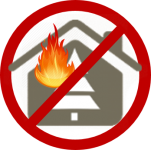
02 Dec Keeping Safe During the Holidays

An Ounce of Prevention…
Untouched for months, household sources of comfort and warmth are once again stirred into activity. But before you crank up the heat or cozy up by the fireplace, be sure that they are ready to operate safely for the upcoming weeks of cooler weather.
- Keep your wood-burning fireplace free of debris. Hire a professional to inspect and clean your chimney.
- Have your central heating & air conditioning unit professionally serviced – especially if you notice a prolonged burning smell during initial heating operation. Be sure to replace all filters and remove dust or buildup from heat registers and vents.
- If you have a gas heater or furnace, contact a licensed heating contractor for an inspection. Check with your local utility company to see if they provide a free service and carbon monoxide detection.
- Extra holiday cooking requires vigilant kitchen safety. Keep flammable objects such as dish towels, curtains, and aprons away from stoves, and don’t wear loose fitting clothing while cooking. If a pan catches fire, cover it with a lid and turn off the heat. Baking soda may be used to extinguish small grease fires, but remember never to use water on an electrical fire, as shock could result.
With All the Holiday Trimmings…
During the holidays, we fill our homes with all varieties of boxes, baubles, and bling. This may mean more crowded living spaces as well as electrical outlets. According to the National Fire Protection Association (NFPA), electrical failures or malfunctions were factors in two-thirds (69%) of household fires involving holiday or decorative lights. Observing smart storage, safe power usage and these household safety tips can ensure you have safe family celebrations this year.
- Place holiday decorations and Christmas tree well away from fireplace or any other heat source. Secure your tree in an appropriate stand, and keep it well watered. The NFPA reports that the risk of fire is higher with natural trees than artificial ones. Researchers found that dry natural trees burned easily, but trees that had been kept moist are unlikely to catch fire unintentionally.
- The U.S. Fire Administration suggests that you do not put your live tree up too early or leave it up for longer than two weeks, and to make sure that all of your home’s exits are accessible and not blocked by decorations. Provide your guests with sufficient walking area, being mindful of tree skirting, gifts, and decorations, in order to prevent unwanted trips or falls.
- While decorating, use nonflammable or flame-retardant tree ornaments. Choose appropriate hardware for placement of decorations and lighting on tree, interior and exterior surfaces. And always observe proper ladder safety when adorning overhead.
- Inspect your holiday lights for bare spots, frayed wires, broken or cracked sockets, or gaps in the insulation. There should be no excessive kinking or wear; and use only lighting listed by an approved testing laboratory like UL, Underwriters Laboratories Inc.
- The general rule of thumb is not to link more than three light strands together – unless the manufacturer indicates it is safe. Connect strings of lights to an extension cord first, before plugging the cord into the outlet, checking the wires periodically; they should not be warm to the touch. And although you may desire a continuous holiday dazzle, the U.S. Fire Administration suggests you never leave holiday lights on unattended.
Planning Ahead…
We certainly don’t want to think about the possibility of a household emergency or fire, but being prepared is wise, and it could be the difference between a memorable holiday adventure and a sad family tragedy. Experts from Kidde Fire Safety say it’s so important that families have enough working smoke alarms throughout their home – and that they know what to do when those smoke alarms sound.
- Kidde recommends a smoke alarm on every floor, and one inside and outside of every bedroom. If your home was built before 1990 – especially before 1970 – chances are, you may only have one or two smoke alarms in your entire house. Smoke alarms should be replaced every ten years and be regularly checked. Test your smoke alarm per manufacturer’s instructions and replace the batteries as needed. If you don’t remember how old your smoke alarm is, it is time to get a new one.
- Every home should have a fire extinguisher in the kitchen and in the garage. Check the pressure and expiration date on all of your fire extinguishers.
- In case of an emergency, all the adults in your household should know the locations and operation of your heating fuel main shutoff, main electrical fuse/breaker box, and all water shutoffs. Keeping a wrench handy will make hasty adjustments easier.
- Most importantly, prepare your family in advance in order to keep anyone from panicking. Have an escape plan and an agreed-upon place to meet in the event of a fire. Remember, from the time a smoke alarm first sounds, you have on the average 3 minutes to get your family to safety.
As the saying goes, “An ounce of prevention is worth a pound of cure.” This is especially true when it comes to keeping your family and friends safe. Observing a regular schedule of preventative home maintenance during the holidays is a worthy investment for the safety of loved-ones and a joyous seasonal celebration.
Listen Saturday mornings to “In the House with Ken & Jared”. Get more Home Tips and show info at the In the House website. For a free estimate on your next Home Improvement Project, visit Universal Roof & Contracting or call now. Orlando: 407-295-7403 Jacksonville: 904-647-3907



